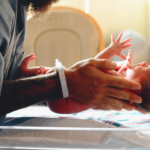
25 Mar Pregnancy: My Rhesus D-negative Pregnancies
Your blood type can affect your pregnancy more than you might realise.
Imagine finding out you’re pregnant when stuck on the other side of the world, and knowing if you don’t get back home to see your doctor as soon as possible, you’re at risk of complications. That’s exactly what happened to Michelle Kuramochi during her first pregnancy as a result of her rhesus-negative blood.
When you have your first antenatal appointment, you will be offered a number of routine blood tests, one of which is to find out your blood group (A, B, AB or O) and your rhesus status (positive or negative). When the mother is RhD negative and her baby is RhD positive, it can cause complications during pregnancy, because the baby will have a protein (D antigen) that can escape into the mother’s bloodstream.
“If this happens, the D antigen can be treated as a foreign invader (just like a bacteria), and the mother’s immune system’s response is to manufacture antibodies against it,” says Associate Professor Steve Robson from RANZCOG (the Royal Australian and New Zealand College of Obstetricians and Gynaecologists).
If the antibodies cross the placenta and attack the baby’s red cells, there can be complications such as foetal anaemia, jaundice, and sometimes miscarriage.
“My sister had a miscarriage with her first pregnancy, and then started bleeding with her second before she was told she was RhD negative,” says Michelle. “I had my blood type checked and was told I had the same thing. I remember my doctor saying, ‘If you find out you are pregnant and start to bleed, make sure you come and see me straight away.”
When I landed in LA, the bleeding had stopped but I felt sick
Michelle did start to bleed, just before she left on a plane for Los Angeles as an international flight attendant. “I assumed I had my period and was disappointed I wasn’t pregnant but thought my husband and I would try again the next month,” she says. “When I landed in LA, the bleeding had stopped but I felt sick, so I took a test and got a positive result.”
Anti-D injections prevent the mother from producing antibodies. “Anti-D injections need to be given to an RhD-negative woman whenever there’s a risk the baby’s cells might be released into her circulation, such as within 72 hours of bleeding, trauma and bumps to the abdomen and birth and medical procedures, such as amniocentesis,” says Steve. “Sometimes the blood cells can be released ‘silently’, and for this reason, anti-D injections are commonly offered at 28 and 34 weeks.”
The injections help prevent Rhesus disease in later pregnancies, which can be very problematic because the mother’s immune system generates much smaller antibodies that can more easily cross the placenta, according to Steve. “Rhesus disease is extremely rare these days, and this is because of the availability of anti-D,” says Steve.
It had taken Michelle and her husband Shinji three-and-a-half years to conceive. “I think a combination of time differences, jetlag and not being home at the ideal times for conception, made it harder for us,” says Michelle. “I was so excited but distressed, knowing that I needed to get back to Australia. I called my flight manager in tears and asked her to let me work the next flight home.”
Fortunately, Michelle’s manager sent her home, allowing her to travel as a passenger in first class. “My original flight was not due to leave for another two days and was returning to Sydney via Melbourne, so I wouldn’t have been home for a while,” says Michelle.
“I was anxious to get an anti-D injection to ensure my baby had a chance.”
Once Michelle arrived home, she was relieved when the doctor quickly administered her anti-D injection and the bleeding stopped. Michelle bled three more times throughout her pregnancy, and each time the injection had to be given. Each one helped her to continue with her pregnancy and allowed her to return to work. “I was allowed to fly up until 26-weeks pregnant or no more than 300 hours flying time from conception, whichever came first,” says Michelle.
She admits she did find her job challenging while pregnant, especially when she was also diagnosed with gestational diabetes at 22 weeks. “The plane aisles are narrow and attendants have to reach to close overhead lockers and bend, turn and push constantly to put food trays in food carts, as the plane flies on an angle, so it was physically hard and tiring. I was lethargic, but I tried to get lots of rest and eat regularly,” she says.
Her daughter Marley was born full term and healthy
Although she had the option of continuing to work on the ground rather than in the air for the rest of her pregnancy, Michelle chose to go on maternity leave at 26 weeks. Her daughter Marley was born full term and healthy. Michelle was also happy to find that her diabetes had also ended when her pregnancy did.
When she fell pregnant with her second child, son Maicah, two years later, Michelle knew better what to expect. Fortunately, Michelle’s doctor was able to monitor her second pregnancy closely. “I was delighted that I had no gestational diabetes and only bled once,” she says. “Having a long-term GP is wonderful when you have a pregnancy complication, as they know you and your history.”
Michelle is mum to Marley (six) and Maicah (four). She works part-time as a flight attendant and is the owner of Little M.
Words by Brooke Tasovac




